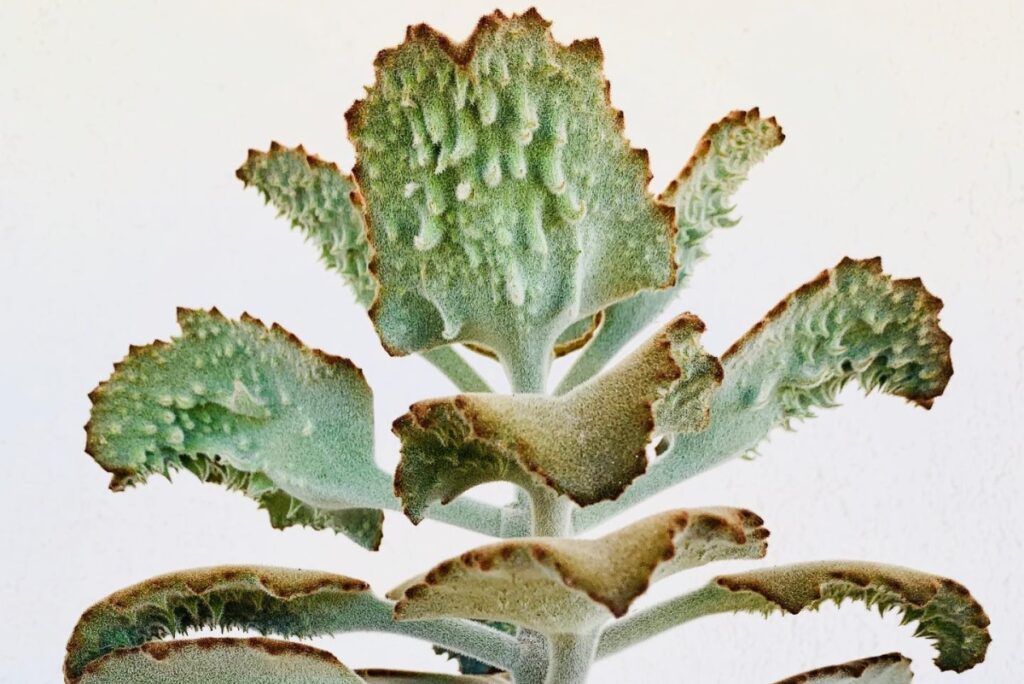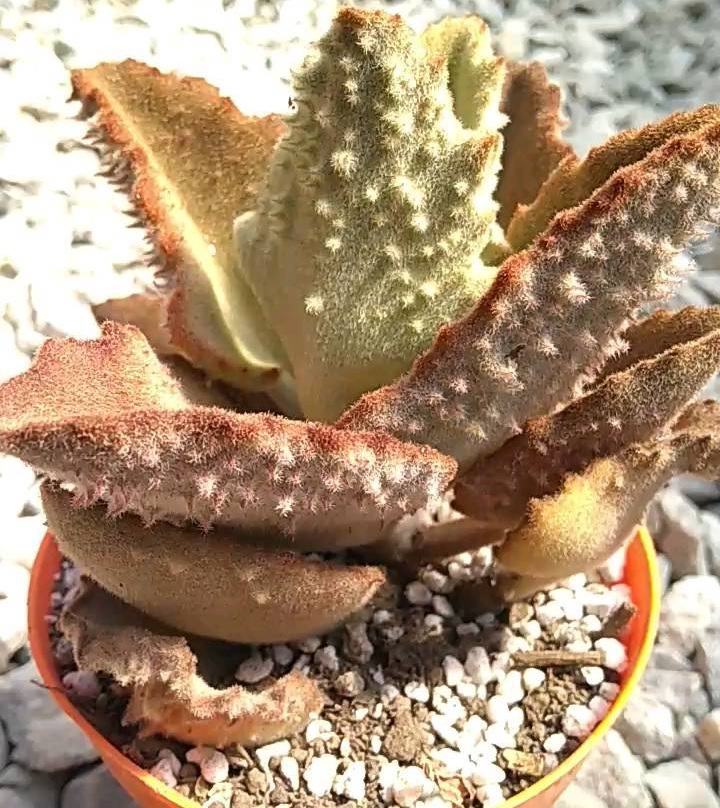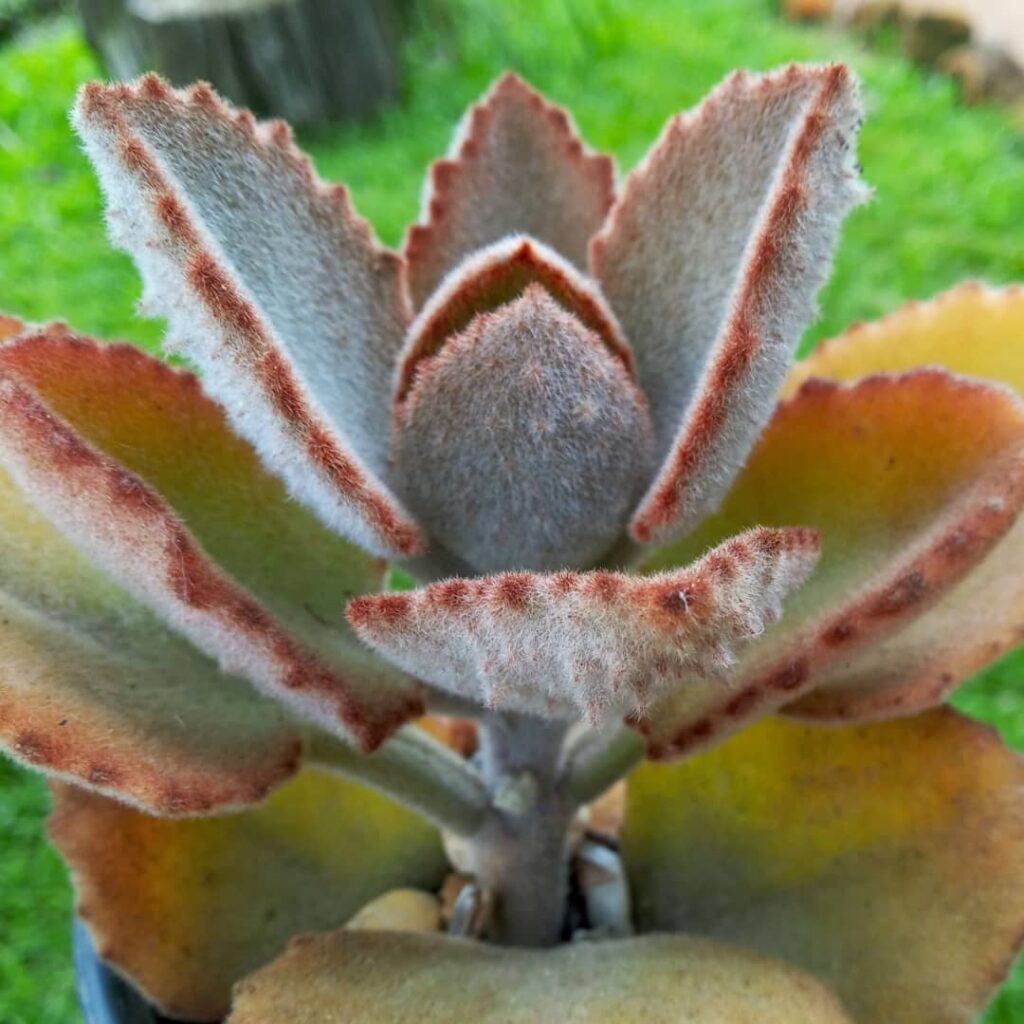Kalanchoe beharensis ‘Fang’ – The Award-Winning Felt Plant with Gnarly Leaves
Get ready to be utterly captivated by one of the most bizarre-looking yet award-winning succulent plants out there! The Kalanchoe beharensis ‘Fang’ is an eccentric beauty with velvety bronze leaves covered in fuzzy silver hairs. But here’s the real showstopper – these large fleshy leaves, reaching up to 4 inches long, are adorned with crazy fang-like protrusions on the undersides. Yeah, you read that right – fangs! While not actually sharp, those gnarly bumps give this succulent some serious attitude. Although the small reddish-orange flowers are cute, let’s be real, it’s those jaw-dropping leaves that steal the show. Keep reading to learn all about caring for and propagating this utterly unique plant!

Contents
About Kalanchoe beharensis ‘Fang’
Native to Madagascar, this bushy succulent has an upright, tree-like habit that can reach 2-3 feet tall and 1-2 feet wide as it matures. Its triangular to lance-shaped leaves have wavy, cupped edges adding to the funky look. The Royal Horticultural Society even awarded it their prestigious Award of Garden Merit for its extraordinary foliage.
While easy to grow, this plant is toxic to dogs and cats, so keep that in mind if you have furry friends around. It’s heat-tolerant but can’t handle cold well, so those in colder climates may need to bring it indoors for winter.
Related Post:
40+ Kalanchoe Lower Classifications With Pictures
How To Care For Kalanchoe beharensis Fang
Light
The ‘Fang’ succulent absolutely craves bright, direct sunlight. South or west-facing windows are perfect for indoor plants. Outdoor plants thrive in full sun, but watch out for scorching summer rays in hot climates – give them some afternoon shade. If needed, supplement with a grow light set on a 12-14 hour daily cycle and positioned a few inches away.
Water
Like most succulents, Kalanchoe ‘Fang’ hates wet feet! Allow the soil to fully dry out between waterings during the growing season, then water thoroughly. In winter, scale back and just provide a light drink every 4-6 weeks to keep it barely moist. The leaves will start to wrinkle when thirsty as a sign it needs a drink.
Soil

Your ‘Fang’ succulent will flourish in a well-drained potting mix made for cacti and succulents. Or make your own by mixing equal parts potting soil, coarse sand or perlite, and pumice or small pebbles for added drainage. Having the right loose, fast-draining soil mix is key.
Fertilizer
These low-maintenance plants rarely need feedings. But for an extra boost, you can fertilize 3-4 times during spring, summer and early fall with a balanced fertilizer diluted to half-strength. Slow-release or liquid fertilizers suitable for succulents and cacti both work well.
Temperature and Humidity
Feeling hot, hot, hot! ‘Fang’ loves warm temps above 55°F. It can handle summer heat and humidity just fine, but not frost or freezing winters. In cold climates, bring it inside before nighttime temps dip below 50°F. Humidity isn’t an issue for this drought-tolerant plant.
Pests and Problems
Typical houseplant pests like mealybugs, spider mites and aphids may bother your ‘Fang’ from time to time. Keep an eye out and treat with insecticidal soap or neem oil if needed. Fungal diseases like leaf spot or powdery mildew can occur from overwatering or poor air circulation. Yellow, dropping leaves also indicate overwatering.
Pruning Tips
Pruning isn’t necessary for this low-maintenance succulent unless you want to trim off any dead or damaged stems and leaves. Use clean, sharp pruners and cut off growth at the base, making clean cuts. This will encourage fuller, bushier growth.

Potting and Repotting
These slow growers only need repotting every 2-3 years max when they outgrow their current pot. Choose a container with drainage holes and use a fresh batch of well-draining cactus/succulent potting mix. Spring is the best time to repot when growth is most active. Water immediately after repotting, then wait for soil to fully dry out before watering again.
Kalanchoe beharensis ‘Fang’ Propagation
One of the best things about the ‘Fang’ succulent is how easy it is to propagate and get new plants! You can multiply this plant using either stem or leaf cuttings. Here’s the step-by-step process:
- Take healthy stem or leaf cuttings from the mother plant using clean, sharp scissors or pruners. Cuttings should be 3-4 inches long.
- Allow the cuttings to callus over for a few days by leaving them out to dry. This forms a protective layer over the cut end and helps prevent rotting.
- Once calloused, you can root the cuttings directly in well-draining potting mix formulated for cacti and succulents.
- Gently set the cuttings on top of the soil mix, making sure the calloused end is in contact with the soil. Space them a few inches apart.
- Do not water the cuttings directly at first. Instead, lightly mist them with a spray bottle once or twice a week.
- Place the cuttings in a warm spot with bright, indirect light. Too much sun can cause them to dry out.
- After a few weeks, you should see new roots and tiny leaves sprouting. This is the sign to begin watering the new plants sparingly.
- Once the roots are well-established in a few months, you can pot up each new ‘Fang’ plant individually for continued growth.
With just a little time and care, you’ll have tons of new Kalanchoe ‘Fang’ babies to share with friends or expand your succulent collection!
So what are you waiting for? Add this wild and wacky award-winner to your indoor jungle or outdoor succulent garden for some truly jaw-dropping, fang-tastic foliar fun!
